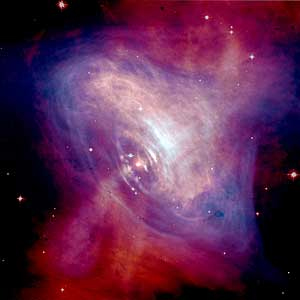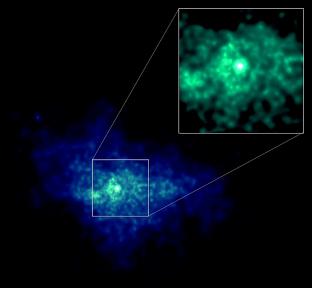Collapse of a Pulsar in the Milky Way


The Reality of Antimatter
By Robert Roy Britt
Senior Science Writer
posted: 07:00 am ET
29 September 2003
Antimatter sounds like the stuff of science fiction, and it is. But it's also very real. Antimatter is created and annihilated in stars every day. Here on Earth it's harnessed for medical brain scans.
"Antimatter is around us each day, although there isn't very much of it," says Gerald Share of the Naval Research Laboratory. "It is not something that can be found by itself in a jar on a table."
So Share went looking for evidence of some in the Sun, a veritable antimatter factory, leading to new results that provide limited fresh insight into these still-mysterious particles.
Simply put, antimatter is a fundamental particle of regular matter with its electrical charge reversed. The common proton has an antimatter counterpart called the antiproton. It has the same mass but an opposite charge. The electron's counterpart is called a positron.
Antimatter particles are created in ultra high-speed collisions.
Looping eruptions on the Sun, like this one on July 24, 1999, create antimatter. Earth is shown for size comparison.
One example is when a high-energy proton in a solar flare collides with carbon, Share explained in an e-mail interview. "It can form a type of nitrogen that has too many protons relative to its number of
neutrons." This makes its nucleus unstable, and a positron is emitted to stabilize the situation.
But positrons don't last long. When they hit an electron, they annihilate and produce energy.
"So the cycle is complete, and for this reason there is so little antimatter around at a given time," Share said.
The antimatter wars
To better understand the elusive nature of antimatter, we must back up to the beginning of time.
In the first seconds after the Big Bang, there was no matter, scientists suspect. Just energy. As the universe expanded and cooled, particles of regular matter and antimatter were formed in almost equal amounts.
But, theory holds, a slightly higher percentage of regular matter developed -- perhaps just one part in a million -- for unknown reasons. That was all the edge needed for regular matter to win the longest running war in the cosmos.
"When the matter and antimatter came into contact they annihilated, and only the residual amount of matter was left to form our current universe," Share says.
Antimatter was first theorized based on work done in 1928 by the physicist Paul Dirac. The positron was discovered in 1932. Science fiction writers latched onto the concept and wrote of antiworlds and antiuniverses.
Potential power
Antimatter has tremendous energy potential, if it could ever be harnessed. A solar flare in July 2002 created about a pound of antimatter, or half a kilo, according to new NASA-led research.
That's enough to power the United States for two days.
Laboratory particle accelerators can produce high-energy antimatter particles, too, but only in tiny quantities. Something on the order of a billionth of a gram or less is produced every year.
Nonetheless, sci-fi writers long ago devised schemes using antimatter to power space travelers beyond light-speed. Antimatter didnít get a bad name, but it sunk into the collective consciousness as a purely
fictional concept. Given some remarkable physics breakthrough, antimatter could in theory power a spacecraft. But NASA researchers say it's nothing that will happen in the foreseeable future.
Meanwhile, antimatter has proved vitally useful for medical purposes.
The fleeting particles of antimatter are also created by the decay of radioactive material, which can be injected into a patient in order to perform Positron Emission Tomography, or PET scan of the brain.
Here's what happens:
A positron that's produced by decay almost immediately finds an electron and annihilates into two gamma rays, Share explains. These gamma rays move in opposite directions, and by recording several of their origin points an image is produced.
Looking at the Sun
In the Sun, flares of matter accelerate already fast-moving particles, which collide with slower particles in the Sun's atmosphere, producing antimatter. Scientists had expected these collisions to happen in relatively dense regions of the solar atmosphere. If that were the case, the density would cause the antimatter to annihilate almost immediately.
Share's team examined gamma rays emitted by antimatter annihilation, as observed by NASA's RHESSI spacecraft in work led by Robert Lin of the University of California, Berkeley.
The research suggests the antimatter perhaps shuffles around, being created in one spot and destroyed in another, contrary to what scientists expect for the ephemeral particles. But the results are
unclear. They could also mean antimatter is created in regions where extremely high temperatures make the particle density 1,000 times lower than what scientists expected was conducive to the process.
Details of the work will be published in Astrophysical Journal Letters
on Oct. 1.
Unknowns remain
Though scientists like to see antimatter as a natural thing, much about it remains highly mysterious. Even some of the fictional portrayals of mirror-image objects have not been proven totally out of this world.
"We cannot rule out the possibility that some antimatter star or galaxy exists somewhere," Share says. "Generally it would look the same as a matter star or galaxy to most of our instruments."
Theory argues that antimatter would behave identical to regular matter gravitationally.
"However, there must be some boundary where antimatter atoms from the antimatter galaxies or stars will come into contact with normal atoms,"
Share notes. "When that happens a large amount of energy in the form of gamma rays would be produced. To date we have not detected these gamma rays even though there have been very sensitive instruments in space to observe them."
The New Age to come,
Will be brought on by,
The collapse of a Pulsar,
Within the Milky Way,
Creating an enormous black hole,
Sucking anything and everything,
And even our Solar System,
Will not escape,
This enormous spectacle.
You see, Black Hole don't give out light,
So it could be an undiscovered Black Hole,
Or an event that is yet to come,
In our Milky way.
GRBs (97-00)
Gamma Ray Bursts (or GRBs) are the most spectacular and powerful explosions in the sky. Their duration lasts from milliseconds to hundreds of seconds, and they tend to cluster into two distinct populations. They are also extremely distant, with redshifts exceeding Z=1, although most of what is known about distances is deduced from the longer duration GRBs. We search for correlation between the GRB event time and location provided by gamma ray satellites. Unfortunately, one of the most powerful detectors (called BATSE on the Compton Gamma Ray Observatory) ceased operation in May of 2000. To increase our search exposure, we have examined BATSE bursts that were uncovered offline by additional analysis (termed "non-triggered" bursts) and GRBs identified by the Interplanetary Network (IPN) of satellites.
WIMPs
A class of dark matter candidates are hypothetical particles known Weakly Interacting Massive Particles (WIMPs). One of the mostly widely studied WIMP is provided by an extension to the standard model of particle physics known as Supersymmetry (or SUSY to its friends). If supersymmetry ideas are correct, then the lightest stable supersymmetric particle could be the dark matter. AMANDA can search for WIMP dark matter indirectly by searching for high energy neutrino emission from the core of the earth or the sun. The idea is that dark matter particles would occasionally inelastically collide with atoms and lose enough energy to become gravitationally bound to the sun or earth. Eventually, the WIMPs spiral down to the core. As the density of dark matter WIMPs increases in the core, they begin to interact and annihilate with each other. Their annihilation produces high energy neutrinos (among other particles).
It is the same force that caused the Tsunami. Others have speculated the Space Vortex Theory could be the cause. But the study of computer stimulations point to a magnitude that is far greater than anything seen on earth. An antimatter the size of a football could result in creating the Tsunami.
Please look at article;
Links between the Earth's Magnetic Field and its effects on its inhabitants.
Tsunami caused by Earth being hit by Antimatter : Oogle
|